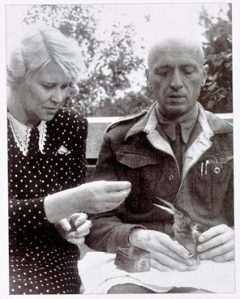Until this book, I am sorry (and a little embarrassed) to admit that I had no idea who Jan and Antonina Zabinski were. That is no longer the case. There were many heroes during WWII; many of whom were unsung. Thanks to the prolific work of author Diane Ackerman, however, the Zabinskis’ story has been told in a very touching and readable non-fiction account.
Jan and Antonina Zabinski were Christian zookeepers horrified by Nazi racism, who capitalized on the Nazis’ obsession with rare animals in order to save over 300 doomed people. Their story has fallen between the seams of history, as radically compassionate acts sometimes do.
The story begins with the heyday of the Warsaw Zoo in Poland, which was lovingly overseen by the Zabinskis. Jan, a no-nonsense Zoologist, was a scientist to his core, and a man who could not abide racial intolerance. His wife Antonina was an intelligent and soft-spoken woman, who had an uncanny knack for understanding animals and their connection to their human keepers. She is the book’s focal point, and it was her remarkable understanding of creatures large and small that helped guide her through the atrocities of the Nazi occupation of Poland.
When the Nazis burst in on Poland, and pillaged almost everything in their path, it was astonishing that the Warsaw Zoo was left standing. Oddly, Nazi fascination with exotic animals was to the benefit of the Zabinskis, as they were permitted to remain at the Zoo, and tend the animals that survived initial bombings. Led by the efforts of Nazi zoologist Lutz Heck, the Germans soon removed the more precious species from the Zabinskis’ care, and relocated them to German Zoos. The remaining animals were shot with cold-blooded malice by a riotous German Officer ‘hunting party,’ who thought it would be great entertainment to kill the caged animals.
Every time I read new accounts of Nazi behavior, I’m more horrified than the last. The word inhuman would be a compliment.
Sorry – back to the review.
Warsaw, as the Zabinskis knew it, had transformed from a city of rich history, to a Ghetto of prisoners.
Once cleared of its creatures, Jan decided to reinvent the Zoo, and turn it into a pig farm. With the ‘goal’ of providing fresh meat for the Nazi troops, the Zoo was allowed to run in this manner for a while. Under the guise of a pig farmer who needed to collect edible scraps for the pigs, Jan started visiting the Warsaw Ghetto. These trips provided an opportunity for Jan to smuggle food in for Ghetto inhabitants, and slowly, steadily, smuggle prisoners out.
When the pig farm was shut down by the Germans, the Zoo reinvented itself again as a fur farm. Providing the Germans with rich fox pelts became the new reason to officially exist, and it provided continued opportunities to hide weapons, Underground documents, and more Ghetto escapees. Both Jan and Antonina (and their young son) had many tense encounters with the Gestapo, and they always talked their way out of life threatening situations. I started to think that they were charmed.
The Zoo became a safe haven. People hid in closets, tunnels, animal enclosures, and even in plain sight. Antonina took care of all of them, while Jan worked tirelessly as a bold member of the Polish Underground. The book’s focus on Antonina offered a true glimpse of humanity during a time when such a thing was scarce. She was remarkable. From her piano playing which warned people to hide, to her affection for every person saved, Antonina welcomed the purpose in her life with open arms.
The Zabinskis saved over 300 people.
Diane Ackerman provides a history lesson unlike any other that I have encountered. She skillfully juxtaposes her descriptions of animals with her account of daily human life in occupied Warsaw. Her devotion to the people of the story leaves the reader with a feeling of personal connection. You’ll feel like you knew them. You’ll feel like you knew Antonina.
This reader wishes she had. 3.5 stars.


Amazing review Elizabeth, I’ve honestly got tears in my eyes for Antonina right now. What a beautiful lady! As was her husband. Amazing.
So happy you liked it! I think you’ll enjoy the book… those people really stay with you.
Amazing review! Sounds like an inspirational book. Will have to check it out. Thanks.
Amazing review. Sounds like an inspirational book. Will have to check it out. Thanks 🙂
Thanks Bookosaur! It definitely falls into the inspirational category. 😉
Pingback: Review: All That I Am « literary hoarders
It looks awesome!! Have you read Things We Couldn’t Say by Diet Eman? She was a young Dutch Christian who was very active in the Dutch Resistance.
I haven’t read that one; thank you for the recommendation! I’ll add that to my to-read list asap. Thanks so much for stopping by!
Elizabeth
No problem! Will check out more books on here! 🙂